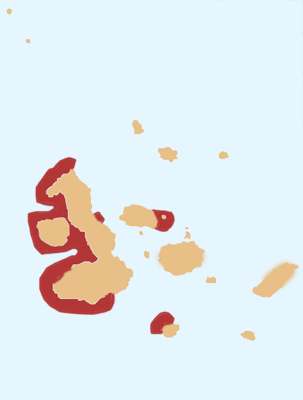
Male swimming
Description
The average Galápagos penguin is 49 centimetres (19 in) long and 2.5 kilograms (5.5 lb) in weight. It is the second smallest species of penguin, after the little penguin. Galápagos penguins have a black head with a white border running from behind the eye, around the black ear coverts and chin, to join on the throat. They have grey-black upperparts and whitish underparts, with two black bands across the breast, the lower band extending down the flanks to the thigh. Juveniles differ in having a wholly dark head, greyer on side and chin, and no breast band. Females are smaller than males.Distribution
Ninety percent of Galápagos penguins live on Fernandina Island and the west coast of Isabela Island, in the western part of the archipelago, but small populations also occur on Santiago, Bartolomé, northern Santa Cruz, and Floreana. The northern tip of Isabela crosses the equator, meaning that some Galápagos penguins live in the northern hemisphere, the only penguins to do so.Ecology and behavior
The penguins are confined to the archipelago, foraging in the cool Cromwell Current during the day and returning to the land at night. They eat small schooling fish, mainly mullet and sardines, and sometimes crustaceans. They normally range only a few kilometers from their breeding sites, depending on the cold, nutrient-rich currents to bring them food.Air temperatures in the Galápagos remain in the range 15–28 °C (59–82 °F). During El Niño seasons, the penguins defer breeding because their food becomes less abundant; this makes the chances of raising offspring successfully unfavorable compared to the chances of dying in the attempt. This was especially detrimental during the 1982-83 El Niño, where a decline in population of 77% was observed.[3] The penguins usually breed when the sea surface temperature is below 25 °C (77 °F). The strong tropical sun is problematic for this species. Their primary means of cooling off is going in the water, but other behavioral adaptations for thermoregulation come into play when they must remain on land. One method involves stretching out their flippers and hunching forward to keep the sun from shining on their feet, which exchange heat rapidly because they have high blood flow and lack insulation. Another method is to pant, using evaporation to cool the throat and airways. Galápagos penguins protect their eggs and chicks from the hot sun by keeping them in deep crevices in the rocks.
Breeding
Juvenile before it has banding markings
Bermudian naturalist Louis L. Mowbray was the first to successfully breed the Galápagos penguins in captivity.[5]
Predators and threats
The species is endangered, with an estimated population size of around 1,500 individuals in 2004, according to a survey by the Charles Darwin Research Station. The population underwent an alarming decline of over 70% in the 1980s, but is slowly recovering. It is currently the rarest penguin species (a status often falsely attributed to the yellow-eyed penguin). Population levels are influenced by the effects of the El Niño Southern Oscillation, which reduces the availability of shoaling fish, leading to low reproduction or starvation. However, humans may be contributing to the decline of this species. On Isabela Island, introduced cats, dogs, and rats attack penguins and destroy their nests. Illegal fishing activity may interrupt the penguins’ nesting, and they are often caught in fishing nets by mistake. Other factors include oil pollution and depletion of fish stocks.Because of the Galápagos penguin's small size, it has many predators. On land, the penguins may fall prey to crabs, snakes, rice rats, cats, Galapagos hawks, and short-eared owls. While in the water they are preyed on by sharks, fur seals, and sea lions.[6] They also face the hazards of unreliable food resources and volcanic activity.[7]
References
Spheniscus mendiculus
Sundevall, 1871



No comments:
Post a Comment
Note: Only a member of this blog may post a comment.